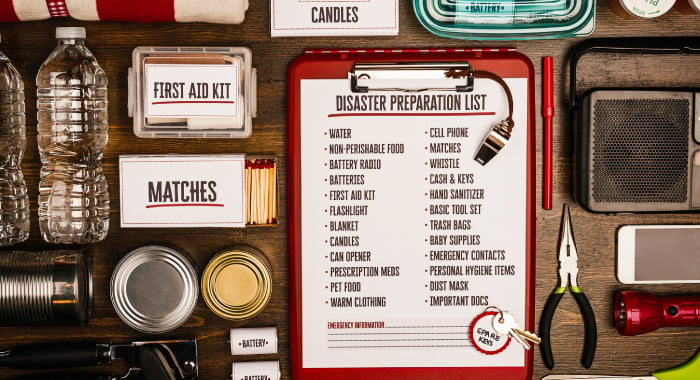With the winter storm season close at hand, now is an excellent time to review your family’s disaster preparedness plan. Being ready for an emergency situation doesn’t just mean having a first aid kit, adequate blankets and a pair of snowshoes – it’s also important to consider your financial preparedness for a disaster.
Being financially prepared for an emergency will help you and your family to better handle the immediate challenges of a disaster as well as to recover more quickly in the long run. For a thorough look at financial disaster preparedness with advice and checklists, take some time to review the Emergency Financial First Aid Kit from FEMA. Here’s a quick summary of what steps are involved in being financially prepared for a disaster:
Step 1: Compile Important Documents
Get a waterproof, fireproof emergency box for your home where you can store important documents including passports and social security cards, pet microchip information, a list of emergency contact numbers, medical information and so on. Along with original documents, this should also be a place to securely store photocopies of your driver’s license and vehicle registration. Importantly, as long as you’re compiling these hard copies, also aim to collect soft copies of key documents and securely store these online, so that no matter the situation, you have fast access to important documents in one central location.
Step 2: Use Mobile Banking – But Also Have Emergency Cash
If you’re not already using mobile banking, now is a good time to make the switch. Moving to mobile helps to take some of your month-to-month financial management online, and it means that if a disaster does occur and you don’t have access to paper statements delivered to your home, you can continue to manage your banking needs as normal. At the same time, it’s also a good idea to have emergency cash stored in a safe location in your home, which is ready to go in case of emergency and not used for any other situation. Cash can be a big asset in an emergency; especially if banks are closed or road conditions make it difficult to reach an ATM.
Step 3: Take Photos of Valuable Belongings
If the worst should happen and you need to activate an insurance policy, it’s good practice to have an up-to-date record of valuables in your home. Take photos or videos of valuable items, with date stamps to verify the time and date that images were captured. Keep these records online and if possible, consider having a paper copy as well stored in your lockbox.
Step 4: Verify Your Insurance Coverage
It’s important to review your insurance policies at regular intervals so you understand what’s covered, and what you would need to do to access benefits after an emergency. Ensure that your current policy is offering the right amount of coverage, or consider boosting this if your situation has changed. You should know what benefits you’re entitled to and have a phone number to contact if needed. Make sure this number is stored as a paper copy with the rest of your emergency items, and not just on your mobile phone, in case you don’t have access to it.
Step 5: Prepare a Contact List of Creditors
Other good phone numbers to have are creditor numbers; for example, for your loan or credit cards, as well as your internet provider, landlord or cell phone provider. This is because in an emergency situation, paying regular bills on time can become more complicated or simply be forgotten if there are more pressing matters at hand. One great option is to set up automated payments ahead of time; but if this isn’t possible, at least have contact information for creditors so you’re ready to explain the situation and work out a plan.
Step 6: Understand What Assistance You’re Entitled Too
There are many disaster relief programs to help you recover financially if the worst should occur. FEMA assistance is available for many homeowners whose property has been damaged or destroyed, and who don’t have another form of insurance. Local organizations can also help to provide shelter, energy bill payment support, food and so on. Prepare in advance by listing organizations in your area so you know where to go for help.
Step 7: Keep an Emergency Savings Fund
While it can be difficult to maintain an emergency savings fund, it’s critical to do so in whatever way is possible for you and your family. Whether it’s a broken furnace or an unexpected blizzard, any emergency situation will likely necessitate having some extra money on hand. Save a little bit every month, even if that means skipping a special dinner out. The peace of mind that comes with having an emergency savings fund will be worth it.
Visit FEMA for more information on financially preparing for a disaster: https://www.fema.gov/sites/default/files/2020-08/effak_Toolkit_20190904.pdf
.png?width=258&height=68&name=Harvard_Primary_Logo_Horiz_RGB%20(2).png)




